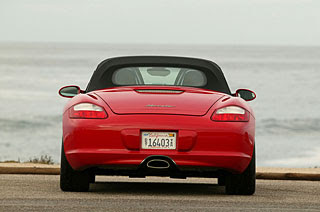



 The engine in the Boxster S has been enlarged from 3.2 to 3.4 liters, and now develops 295 horsepower at 6250 rpm - 15 horsepower more than its predecessor. Torque has also swelled 15 lb.-ft., to 251 lb.-ft. The Boxster S sprints from 0 to 60 mph in just 5.1 seconds (0-100 km/h, 5.4 sec.) - a tenth of a second quicker than the previous model. This open sports car's top test-track speed has risen 2 mph to 169 mph (272 km/h). This heady performance comes at little cost to efficiency, as the Boxster S manages a city/hwy fuel-economy rating of 20/28 MPG with the standard six-speed transmission.
The engine in the Boxster S has been enlarged from 3.2 to 3.4 liters, and now develops 295 horsepower at 6250 rpm - 15 horsepower more than its predecessor. Torque has also swelled 15 lb.-ft., to 251 lb.-ft. The Boxster S sprints from 0 to 60 mph in just 5.1 seconds (0-100 km/h, 5.4 sec.) - a tenth of a second quicker than the previous model. This open sports car's top test-track speed has risen 2 mph to 169 mph (272 km/h). This heady performance comes at little cost to efficiency, as the Boxster S manages a city/hwy fuel-economy rating of 20/28 MPG with the standard six-speed transmission.The 2.7-liter Boxster engine now develops an additional 5 horsepower, bringing peak output to 245 horsepower. Torque has also increased, from 199 to 201 lb.-ft., peaking 100 rpm earlier with a broad torque plateau from 4600 to 6000 rpm. With the standard 5-speed manual transmission, the '07 Boxster accelerates from a standstill to 60 mph in just 5.8 seconds (0-100 km/h, 6.1 sec.), and has a top test-track speed of 160 mph (258 km/h). With the optional six-speed manual gearbox, top test-track speed increases to 162 mph (260 km/h). Fuel economy on the Boxster model is particularly impressive. With the standard 5-speed manual transmission, it achieves a city/hwy rating of 23/32 MPG.
For 2007, the Boxster and Boxster S can be optioned with the revised Tiptronic S transmission, which features new hydraulics and electronics to improve responsiveness, and also provides variable shift programs. Combined with the optional Sport Chrono Package, the sporting characteristics of both these mid-engined roadsters are enhanced. With the Sport mode engaged, up- and downshifts are only made at engine speeds above 3000 rpm, and downshifts for engine braking are subject to less delay and take place at higher engine speeds. In the manual-shift mode, up-shifts are not made automatically when the engine reaches its rev limiter.
No comments:
Post a Comment